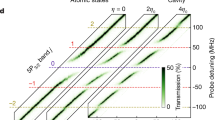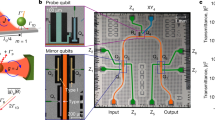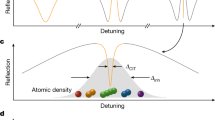Abstract
Multiple quantum emitters coupled to a single cavity mode appear in many situations, including quantum technologies and polaritonic chemistry. The ideal case of identical emitters is modelled in terms of symmetric states, and understood in terms of polaritons. In the practically relevant case of an inhomogeneous frequency distribution, this simple picture breaks down and new features emerge. Here we observe the transition from a disordered regime to a polaritonic one with only two resonances, using the high degree of control in a strongly coupled cold-atom system where the ratio between coupling strength and frequency inhomogeneities can be tuned. The polaritons are much narrower than the frequency distribution, as predicted in the context of cavity protection. We find that the concentration of photonic weight of the coupled light–matter states is a key parameter for this transition and demonstrate that a simple parameter based on the statistics of transmission count spectra provides an experimental proxy for this theoretical quantity. Moreover, we realize a dynamically modulated Tavis–Cummings model to produce a comb of narrow polariton resonances protected from disorder, with potential applications to quantum networks.
This is a preview of subscription content, access via your institution
Access options
Access Nature and 54 other Nature Portfolio journals
Get Nature+, our best-value online-access subscription
$29.99 / 30 days
cancel any time
Subscribe to this journal
Receive 12 print issues and online access
$209.00 per year
only $17.42 per issue
Buy this article
- Purchase on Springer Link
- Instant access to full article PDF
Prices may be subject to local taxes which are calculated during checkout




Similar content being viewed by others
Code availability
The data that support the findings of this study are available via Zenodo at https://doi.org/10.5281/zenodo.7308847.
References
Kimble, H. J. Strong interactions of single atoms and photons in cavity QED. Phys. Scr. 1998, 127 (1998).
Haroche, S. & Raimond, J.-M. Exploring the Quantum: Atoms, Cavities, and Photons (Oxford Univ. Press, 2006).
Solnyshkov, D. D. et al. Microcavity polaritons for topological photonics [Invited]. Opt. Mater. Express 11, 1119–1142 (2021).
Blais, A., Girvin, S. M. & Oliver, W. D. Quantum information processing and quantum optics with circuit quantum electrodynamics. Nat. Phys. 16, 247–256 (2020).
Chang, D. E., Douglas, J. S., González-Tudela, A., Hung, C.-L. & Kimble, H. J. Colloquium: quantum matter built from nanoscopic lattices of atoms and photons. Rev. Mod. Phys. 90, 031002 (2018).
Ebbesen, T. W. Hybrid light–matter states in a molecular and material science perspective. Acc. Chem. Res. 49, 2403–2412 (2016).
Bussières, F. et al. Prospective applications of optical quantum memories. J. Mod. Opt. 60, 1519–1537 (2013).
Heshami, K. et al. Quantum memories: emerging applications and recent advances. J. Mod. Opt. 63, 2005–2028 (2016).
Zhong, T., Kindem, J. M., Rochman, J. & Faraon, A. Interfacing broadband photonic qubits to on-chip cavity-protected rare-earth ensembles. Nat. Commun. 8, 14107 (2017).
Haas, F., Volz, J., Gehr, R., Reichel, J. & Esteve, J. Entangled states of more than 40 atoms in an optical fiber cavity. Science 344, 180–183 (2014).
McConnell, R., Zhang, H., Hu, J., Ćuk, S. & Vuletić, V. Entanglement with negative Wigner function of almost 3,000 atoms heralded by one photon. Nature 519, 439–442 (2015).
Welte, S., Hacker, B., Daiss, S., Ritter, S. & Rempe, G. Cavity carving of atomic Bell states. Phys. Rev. Lett. 118, 210503 (2017).
Leroux, I. D., Schleier-Smith, M. H. & Vuletić, V. Implementation of cavity squeezing of a collective atomic spin. Phys. Rev. Lett. 104, 073602 (2010).
Schleier-Smith, M. H., Leroux, I. D. & Vuletić, V. States of an ensemble of two-level atoms with reduced quantum uncertainty. Phys. Rev. Lett. 104, 073604 (2010).
Ma, J., Wang, X., Sun, C. P. & Nori, F. Quantum spin squeezing. Phys. Rep. 509, 89–165 (2011).
Hosten, O., Engelsen, N. J., Krishnakumar, R. & Kasevich, M. A. Measurement noise 100 times lower than the quantum-projection limit using entangled atoms. Nature 529, 505–508 (2016).
Pezzè, L., Smerzi, A., Oberthaler, M. K., Schmied, R. & Treutlein, P. Quantum metrology with nonclassical states of atomic ensembles. Rev. Mod. Phys. 90, 035005 (2018).
Baumann, K., Guerlin, C., Brennecke, F. & Esslinger, T. Dicke quantum phase transition with a superfluid gas in an optical cavity. Nature 464, 1301–1306 (2010).
Kroeze, R. M., Guo, Y., Vaidya, V. D., Keeling, J. & Lev, B. L. Spinor self-ordering of a quantum gas in a cavity. Phys. Rev. Lett. 121, 163601 (2018).
Muniz, J. A. et al. Exploring dynamical phase transitions with cold atoms in an optical cavity. Nature 580, 602–607 (2020).
Periwal, A. et al. Programmable interactions and emergent geometry in an array of atom clouds. Nature 600, 630–635 (2021).
Basov, D. N., Asenjo-Garcia, A., Schuck, P. J., Zhu, X. & Rubio, A. Polariton panorama. Nanophotonics 10, 549–577 (2020).
Tavis, M. & Cummings, F. W. Exact solution for an N-molecule—radiation-field Hamiltonian. Phys. Rev. 170, 379–384 (1968).
Orgiu, E. et al. Conductivity in organic semiconductors hybridized with the vacuum field. Nat. Mater. 14, 1123–1129 (2015).
Schachenmayer, J., Genes, C., Tignone, E. & Pupillo, G. Cavity-enhanced transport of excitons. Phys. Rev. Lett. 114, 196403 (2015).
Gonzalez-Ballestero, C., Feist, J., Gonzalo Badía, E., Moreno, E. & Garcia-Vidal, F. J. Uncoupled dark states can inherit polaritonic properties. Phys. Rev. Lett. 117, 156402 (2016).
Botzung, T. et al. Dark state semilocalization of quantum emitters in a cavity. Phys. Rev. B 102, 144202 (2020).
Chávez, N. C., Mattiotti, F., Méndez-Bermúdez, J. A., Borgonovi, F. & Celardo, G. L. Disorder-enhanced and disorder-independent transport with long-range hopping: application to molecular chains in optical cavities. Phys. Rev. Lett. 126, 153201 (2021).
Mivehvar, F., Piazza, F., Donner, T. & Ritsch, H. Cavity QED with quantum gases: new paradigms in many-body physics. Adv. Phys. 70, 1–153 (2021).
Houdré, R., Stanley, R. P. & Ilegems, M. Vacuum-field Rabi splitting in the presence of inhomogeneous broadening: resolution of a homogeneous linewidth in an inhomogeneously broadened system. Phys. Rev. A 53, 2711–2715 (1996).
Kurucz, Z., Wesenberg, J. H. & Mølmer, K. Spectroscopic properties of inhomogeneously broadened spin ensembles in a cavity. Phys. Rev. A 83, 053852 (2011).
Diniz, I. et al. Strongly coupling a cavity to inhomogeneous ensembles of emitters: potential for long-lived solid-state quantum memories. Phys. Rev. A 84, 063810 (2011).
Putz, S. et al. Protecting a spin ensemble against decoherence in the strong-coupling regime of cavity QED. Nat. Phys. 10, 720–724 (2014).
Breeze, J. D., Salvadori, E., Sathian, J., Alford, N. M. & Kay, C. W. M. Room-temperature cavity quantum electrodynamics with strongly coupled Dicke states. npj Quantum Inf. 3, 40 (2017).
Lukin, D. M. et al. Spectrally reconfigurable quantum emitters enabled by optimized fast modulation. npj Quantum Inf. 6, 80 (2020).
Craiciu, I. et al. Multifunctional on-chip storage at telecommunication wavelength for quantum networks. Optica 8, 114–121 (2021).
Mishra, S. D., Trivedi, R., Safavi-Naeini, A. H. & Vučković, J. Control design for inhomogeneous-broadening compensation in single-photon transducers. Phys. Rev. Appl. 16, 044025 (2021).
White, A. D., Trivedi, R., Narayanan, K. & Vučković, J. Enhancing superradiance in spectrally inhomogeneous cavity QED systems with dynamic modulation. ACS Photon. 9, 2467–2472 (2022).
Hunger, D. et al. A fiber Fabry–Pérot cavity with high finesse. New J. Phys. 12, 065038 (2010).
Garcia, S., Ferri, F., Ott, K., Reichel, J. & Long, R. Dual-wavelength fiber Fabry-Pérot cavities with engineered birefringence. Opt. Express 26, 22249–22263 (2018).
Garcia, S., Ferri, F., Reichel, J. & Long, R. Overlapping two standing waves in a microcavity for a multi-atom photon interface. Opt. Express 28, 15515–15528 (2020).
Ferri, F., Garcia, S., Baghdad, M., Reichel, J. & Long, R. Mapping optical standing-waves of an open-access Fabry–Pérot cavity with a tapered fiber. Rev. Sci. Instrum. 91, 033104 (2020).
Brantut, J. P. et al. Light-shift tomography in an optical-dipole trap for neutral atoms. Phys. Rev. A 78, 031401 (2008).
Dubail, J., Botzung, T., Schachenmayer, J., Pupillo, G. & Hagenmüller, D. Large random arrowhead matrices: multifractality, semilocalization, and protected transport in disordered quantum spins coupled to a cavity. Phys. Rev. A 105, 023714 (2022).
Debnath, K., Zhang, Y. & Mølmer, K. Collective dynamics of inhomogeneously broadened emitters coupled to an optical cavity with narrow linewidth. Phys. Rev. A 100, 053821 (2019).
Clark, L. W. et al. Interacting Floquet polaritons. Nature 571, 532–536 (2019).
Shlesinger, I. et al. Time-frequency encoded single-photon generation and broadband single-photon storage with a tunable subradiant state. Optica 8, 95–105 (2021).
Piñeiro Orioli, A., Thompson, J. K. & Rey, A. M. Emergent dark states from superradiant dynamics in multilevel atoms in a cavity. Phys. Rev. X 12, 011054 (2022).
Lei, M. et al. Many-body cavity quantum electrodynamics with driven inhomogeneous emitters. Preprint at https://arxiv.org/abs/2208.04345 (2022).
Barredo, D., de Léséleuc, S., Lienhard, V., Lahaye, T. & Browaeys, A. An atom-by-atom assembler of defect-free arbitrary two-dimensional atomic arrays. Science 354, 1021–1023 (2016).
Endres, M. et al. Atom-by-atom assembly of defect-free one-dimensional cold atom arrays. Science 354, 1024–1027 (2016).
Deist, E., Gerber, J. A., Lu, Y.-H., Zeiher, J. & Stamper-Kurn, D. M. Superresolution microscopy of optical fields using tweezer-trapped single atoms. Phys. Rev. Lett. 128, 083201 (2022).
Sauerwein, N. et al. Engineering random spin models with atoms in a high-finesse cavity. Preprint at https://arxiv.org/abs/2208.09421 (2022).
Ferri, F. et al. An optical elevator for precise delivery of cold atoms using an acousto-optical deflector. New J. Phys. 24, 043013 (2022).
Johansson, J. R., Nation, P. D. & Nori, F. QuTiP 2: a Python framework for the dynamics of open quantum systems. Comput. Phys. Commun. 184, 1234–1240 (2013).
Acknowledgements
We thank G. Pupillo and J. Schachenmayer for discussion within the ANR project CLIMAQS. This project has received funding from Agence Nationale de la Recherche (ANR) (SAROCEMA project, ANR-14-CE32-0002) and European Research Council (ERC) under the European Union’s Horizon 2020 research and innovation programme via grant agreement no. 671133 (EQUEMI project). It has been supported by Region Ile-de-France in the framework of DIM SIRTEQ. S.S. acknowledges funding from the European Union under the Marie Skłodowska-Curie Individual Fellowship Programme H2020-MSCA-IF-2014 (project no. 658253).
Author information
Authors and Affiliations
Contributions
M.B., F.F. and R.L. built the experimental setup. M.B., P.-A.B., S.S., F.F. and R.L. performed the measurements and analysed the data. P.-A.B., S.S., J.R. and R.L. interpreted the results and wrote the manuscript with input from all the authors.
Corresponding author
Ethics declarations
Competing interests
The authors declare no competing interests.
Peer review
Peer review information
Nature Physics thanks Zhenjie Yan and the other, anonymous, reviewer(s) for their contribution to the peer review of this work.
Additional information
Publisher’s note Springer Nature remains neutral with regard to jurisdictional claims in published maps and institutional affiliations.
Extended data
Extended Data Fig. 1 Simulated atomic frequency distribution for different trap depths.
For each trap depth U0, the temperature T used in the simulation corresponds to the typical experimental value based on time-of-flight measurements. When U0 increases, the mean frequency of the distribution decreases linearly – as expected with red-detuned off-resonant light – and the width Δω of the distribution increases. At low trap depth U0 = 310 ± 10 μK, the distribution has mainly one lobe, corresponding to the \(\left\vert F=2\right\rangle \to \left\vert {F}^{{\prime} }=3\right\rangle\) transition. For larger trap depths, two-photon couplings at 1559 nm mix the excited state hyperfine levels and two extra lobes appear in the distributions, at lower frequencies, corresponding roughly to transitions \(\left\vert F=2\right\rangle \to \left\vert {F}^{{\prime} }=2\right\rangle\) and \(\left\vert F=2\right\rangle \to \left\vert {F}^{{\prime} }=1\right\rangle\). This illustrates the tunability of the inhomogeneous distribution with the intensity of the trapping field.
Extended Data Fig. 2 Single-shot experimental spectrum.
As we probe the coupled system in the low excitation regime, we collect few photons in transmission and the spectrum is discretized (orange dots). For each spectrum, we compute the fraction Fout of photons (identified with black triangles) that lies outside of a frequency window Δf/2π (green colored area), centered on each peak distribution (red and blue dashed lines).
Extended Data Fig. 3 Robustness of Fout with respect to the size of the exclusion window.
Here, we show Fout for several values of Δf/2π chosen to define the exclusion window, together with the simulated sum of the two highest PW, SPW, as in Fig. 3 of the main text (red dots). The result is rather robust: when Δf/2π decreases, the shape of Fout remains the same and is shifted upwards as expected. Data are presented as mean values ± s.e.m. obtained with an average of 55 spectra per point.
Supplementary information
Supplementary Information
Supplementary sections I–III, figs. 1 and 2 and tables I and II.
Rights and permissions
Springer Nature or its licensor (e.g. a society or other partner) holds exclusive rights to this article under a publishing agreement with the author(s) or other rightsholder(s); author self-archiving of the accepted manuscript version of this article is solely governed by the terms of such publishing agreement and applicable law.
About this article
Cite this article
Baghdad, M., Bourdel, PA., Schwartz, S. et al. Spectral engineering of cavity-protected polaritons in an atomic ensemble. Nat. Phys. 19, 1104–1109 (2023). https://doi.org/10.1038/s41567-023-02035-1
Received:
Accepted:
Published:
Issue Date:
DOI: https://doi.org/10.1038/s41567-023-02035-1



